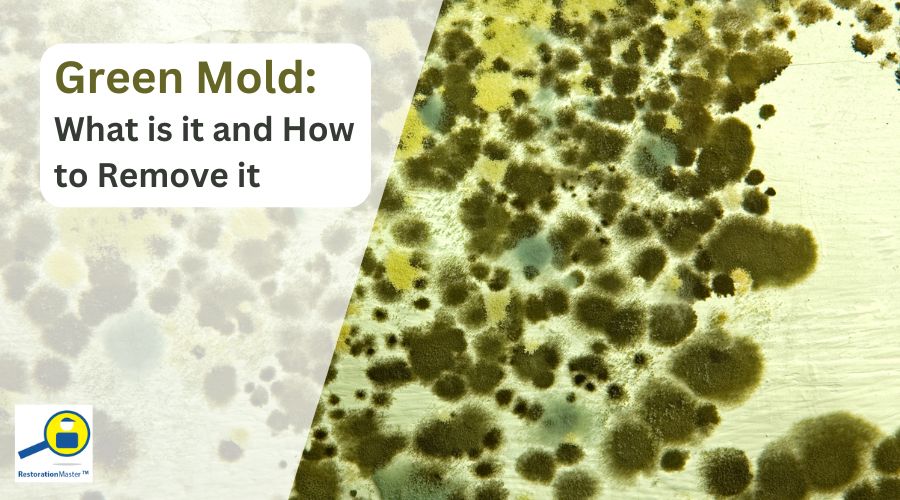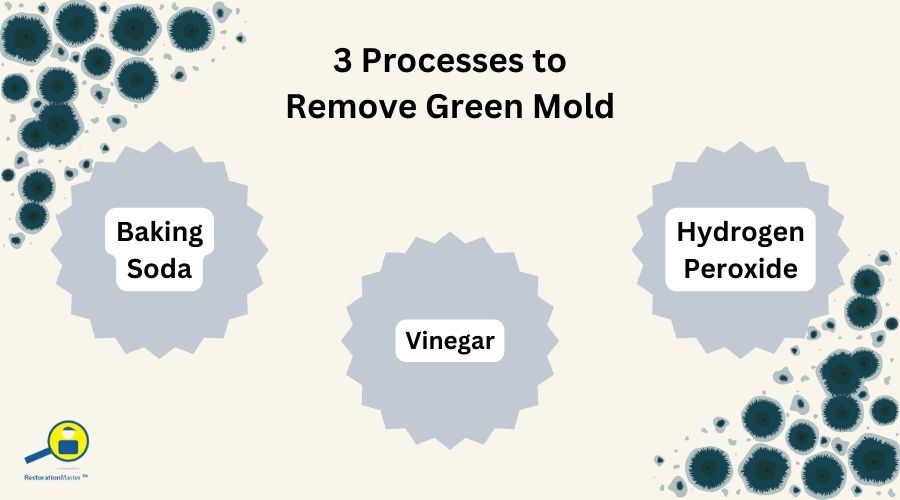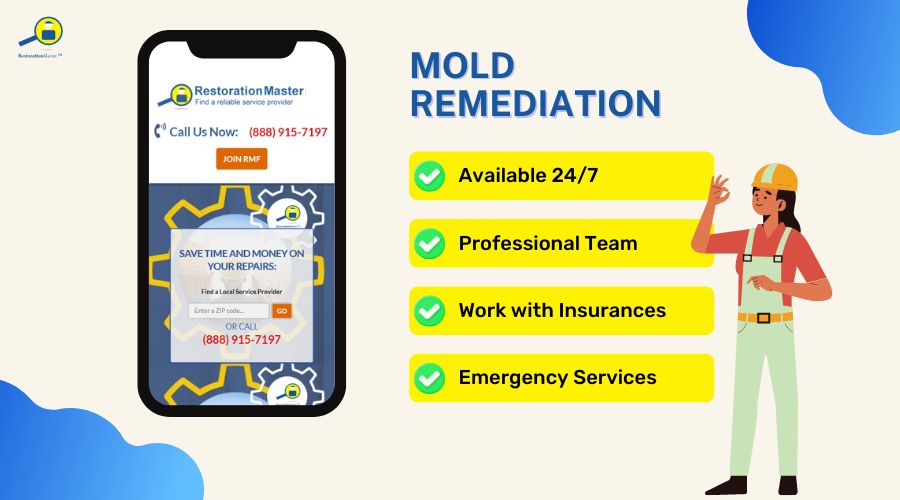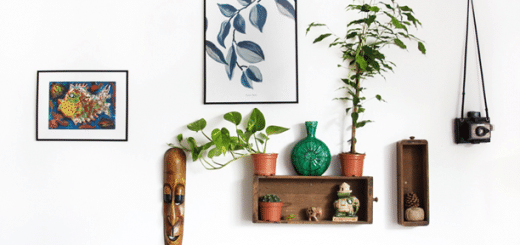Green Mold: What is it and How to Remove It
Thousands of species of green moldMold is a type of fungus that grows in damp or humid conditi... More blanket our planet. In comparison, hundreds of thousands of moldMold is a type of fungus that grows in damp or humid conditi... More types of all kinds invisibly meander through the environment. MoldMold is a type of fungus that grows in damp or humid conditi... More sporesSpores are microscopic reproductive units of fungi or mold t... More spread rapidly, contaminating the air and surfaces within buildings. Green, blue, pink, yellow or black—no matter what color moldMold is a type of fungus that grows in damp or humid conditi... More assumes, the fungi are toxic to humans, especially when sporesSpores are microscopic reproductive units of fungi or mold t... More flourish inside a dwelling or place of business.

About Green Mold
Green moldMold is a type of fungus that grows in damp or humid conditi... More is far from being a specific type of moldMold is a type of fungus that grows in damp or humid conditi... More. Rather, multiple species of fungiFungi are a group of organisms, including mold, mildew, and ... More with greenish-hued sporesSpores are microscopic reproductive units of fungi or mold t... More are referred to as green moldMold is a type of fungus that grows in damp or humid conditi... More.
Three common types of moldMold is a type of fungus that grows in damp or humid conditi... More with greenish sporesSpores are microscopic reproductive units of fungi or mold t... More include Cladosporium, Aspergillus and Penicillium. Be aware that these three moldMold is a type of fungus that grows in damp or humid conditi... More types do not always take on a greenish tint; sporesSpores are microscopic reproductive units of fungi or mold t... More may be blue, while others vary in color, such as black.
Although moldMold is a type of fungus that grows in damp or humid conditi... More is often characterized as having negative impacts, green moldMold is a type of fungus that grows in damp or humid conditi... More can have beneficial impacts. Some species of green moldMold is a type of fungus that grows in damp or humid conditi... More is used in the production of antibiotics like penicillin and in cheese-making, where others can cause spoilage in food products, damage to crops, and health issues in humans.
Is Green Mold Dangerous
Like all moldMold is a type of fungus that grows in damp or humid conditi... More, green moldMold is a type of fungus that grows in damp or humid conditi... More is toxic and poses as a health risk to humans. While people breathe moldMold is a type of fungus that grows in damp or humid conditi... More sporesSpores are microscopic reproductive units of fungi or mold t... More every day, certain conditions provoke mold-related illnesses. People with weakened immune systems are more vulnerable when moldMold is a type of fungus that grows in damp or humid conditi... More growth occurs indoors. Green molds, like Aspergillus, can spur the onsetOnset refers to the beginning or initial appearance of damag... More of pneumonia and lung inflammation.
MoldMold is a type of fungus that grows in damp or humid conditi... More triggers reactions like coughing, runny nose, watery eyes and itchy skin, in those susceptible to allergies and asthma. Even those with no history of respiratory conditions experience allergy symptoms when inhabiting a space infested with green moldMold is a type of fungus that grows in damp or humid conditi... More colonies.
Green Mold vs. Black Mold
Black mold and green moldMold is a type of fungus that grows in damp or humid conditi... More are two common types of fungiFungi are a group of organisms, including mold, mildew, and ... More that can infest homes and buildings, posing distinct risks and challenges.
Black Mold
- Species: StachybotrysStachybotrys is a type of black mold (often called “black ... More chartarum
- Appearance: Slimy when wet, often seen with a dark green to black hue.
- Health Risks: Produces harmful mycotoxinsMycotoxins are toxic substances produced by certain types of... More that can cause health issues.
- Environment: Prefers high-cellulose materials like paper and wood, and thrives in areas with high moisture.

Green Mold
- Species: Aspergillus, Penicillium, or Cladosporium
- Appearance: Appears powdery, varying from light to dark green.
- Health Risks: Can leadLead is a heavy metal that can be toxic to humans, especiall... More to respiratory issues or allergic reactions, although not as severe as black moldMold is a type of fungus that grows in damp or humid conditi... More.
- Environment: Grows on a variety of surfaces such as food, plants, walls, and damp areas like bathrooms, kitchens, and basements.
Understanding the difference between black moldMold is a type of fungus that grows in damp or humid conditi... More is crucial for identification and management of moldMold is a type of fungus that grows in damp or humid conditi... More infestations to protect building structureStructure refers to the framework or components of a buildin... More and health.
Test for Mold When Seeing Green Indoors
Green molds may be identified by their greenish hue. However, green moldMold is a type of fungus that grows in damp or humid conditi... More may be difficult to recognize, especially since the green moldMold is a type of fungus that grows in damp or humid conditi... More may appear as different colors on various surfaces. Splotches of varying hues of green and green-grey in darkened, damp recesses are a certain indication of green moldMold is a type of fungus that grows in damp or humid conditi... More. Green moldMold is a type of fungus that grows in damp or humid conditi... More also commonly grows alongside molds of varying types, like black or pink moldMold is a type of fungus that grows in damp or humid conditi... More.
Wood is a primary target for mold. Wooden floors, ceiling beams, and walls can host green moldMold is a type of fungus that grows in damp or humid conditi... More colonies. The dark, confined spaces of kitchen cabinetry supply ample nutrients for green moldMold is a type of fungus that grows in damp or humid conditi... More to flourish on even food, like bread.
While green moldMold is a type of fungus that grows in damp or humid conditi... More may be easy to spot if the growth appears tinted green, only a laboratory test can prove if the moldMold is a type of fungus that grows in damp or humid conditi... More belongs to certain species that produce green moldMold is a type of fungus that grows in damp or humid conditi... More.
MoldMold is a type of fungus that grows in damp or humid conditi... More test kits are available in abundant supply, giving property owners the ability to determine if unsightly, musty eyesores parading as fungiFungi are a group of organisms, including mold, mildew, and ... More are indeed moldMold is a type of fungus that grows in damp or humid conditi... More. Mold removal and remediation services also provide professional moldMold is a type of fungus that grows in damp or humid conditi... More inspections.
How to Remove Green Mold
MoldMold is a type of fungus that grows in damp or humid conditi... More of any type must be stopped at the source, which is typically moisture. Fix any plumbing leaks, caulk any cracks in the foundation, and seal flaws at the base of windows to stop indoor dampness. Since green moldMold is a type of fungus that grows in damp or humid conditi... More, similar to all moldMold is a type of fungus that grows in damp or humid conditi... More, feeds on water and a food source (wood, drywall and clothing, among other nutrient-rich sources), eliminating the moisture problem will bring moldMold is a type of fungus that grows in damp or humid conditi... More growth to a standstill.
Once indoor moisture is controlled, any existing moldMold is a type of fungus that grows in damp or humid conditi... More colonies can be subsequently handled. Large infestations of existing green moldMold is a type of fungus that grows in damp or humid conditi... More can be tackled with fungicide. Experts also recommend using a vacuum with a HEPA filter to suction in the moldMold is a type of fungus that grows in damp or humid conditi... More sporesSpores are microscopic reproductive units of fungi or mold t... More. The HEPA filter prevents moldMold is a type of fungus that grows in damp or humid conditi... More sporesSpores are microscopic reproductive units of fungi or mold t... More from bursting into the open air and contaminating other areas of the property.

Small moldMold is a type of fungus that grows in damp or humid conditi... More colonies may be dislodged via do-it-yourself home remedies, using baking soda, hydrogen peroxide or vinegar:
- Baking soda – Form a solutionA solution is a homogeneous mixture of two or more substance... More of one part baking soda and one part water in a spray bottle. Spray the solutionA solution is a homogeneous mixture of two or more substance... More alongside the surface of the area affected by green moldMold is a type of fungus that grows in damp or humid conditi... More. Let the application sit for ten minutes. A wet spongeA sponge is a porous material used to absorb liquids or clea... More can be used to wipe away the moldMold is a type of fungus that grows in damp or humid conditi... More. Repeat until the moldMold is a type of fungus that grows in damp or humid conditi... More is no longer visible. Once the spot is thoroughly dry, the moldMold is a type of fungus that grows in damp or humid conditi... More will be effectively dislodged.
- Hydrogen peroxide – A solutionA solution is a homogeneous mixture of two or more substance... More of three percent hydrogen peroxide and water will work to eliminate minor moldMold is a type of fungus that grows in damp or humid conditi... More growth. Apply the solutionA solution is a homogeneous mixture of two or more substance... More to the moldMold is a type of fungus that grows in damp or humid conditi... More infestation and wait ten minutes. Wipe away the moldMold is a type of fungus that grows in damp or humid conditi... More with a clean cloth.
- Use the hydrogen peroxide only on surfaces that will not discolor. Moldy upholstery and carpeting are not ideal areas to use hydrogen peroxide, since the solutionA solution is a homogeneous mixture of two or more substance... More will bleach certain fabric.
- Vinegar – Mix vinegar and water into a spray bottle. Spray the solutionA solution is a homogeneous mixture of two or more substance... More on the surface ridden with moldMold is a type of fungus that grows in damp or humid conditi... More. Let the vinegar and water sit for an hour. Wipe away the moldMold is a type of fungus that grows in damp or humid conditi... More with a wet spongeA sponge is a porous material used to absorb liquids or clea... More.
The sponges and cloths used to clean the green moldMold is a type of fungus that grows in damp or humid conditi... More serve as moisture-rich, nourishing hosts. Avoid worsening and spreading the moldMold is a type of fungus that grows in damp or humid conditi... More sporesSpores are microscopic reproductive units of fungi or mold t... More after implementing any of the above processes by immediately discarding the sponges and cloths involved in the moldMold is a type of fungus that grows in damp or humid conditi... More removal.
Applying an antifungal paint to the surfaces after cleaning can also prevent a resurgence of moldMold is a type of fungus that grows in damp or humid conditi... More.
When to Call a Professional
The three processes above will eradicate light moldMold is a type of fungus that grows in damp or humid conditi... More. Property owners are encouraged to make efforts to dislodge green moldMold is a type of fungus that grows in damp or humid conditi... More growth from small areas, such as spaces less than ten square feet. When green moldMold is a type of fungus that grows in damp or humid conditi... More has overcome a large expanse of ten square feet or more, a professional mold removal and remediation service is necessary to address the problem.

Professional mold remediationMold remediation is the process of identifying, removing, an... More teams are equipped to handle any level of moldMold is a type of fungus that grows in damp or humid conditi... More growth, whether the sporesSpores are microscopic reproductive units of fungi or mold t... More have taken hold in a small area under the sink or have expanded into monstrous splotches along the basement walls. Technicians are highly trained to detect where the moldMold is a type of fungus that grows in damp or humid conditi... More originated and stop the moisture that caused the cultivation of moldMold is a type of fungus that grows in damp or humid conditi... More sporesSpores are microscopic reproductive units of fungi or mold t... More.
Mold remediationMold remediation is the process of identifying, removing, an... More technicians first develop a remediation plan that adheres to established procedures. Then advanced technology is used to remove all moldMold is a type of fungus that grows in damp or humid conditi... More sporesSpores are microscopic reproductive units of fungi or mold t... More and prevent future outbreaks. Swift action is the best remedy for removing green moldMold is a type of fungus that grows in damp or humid conditi... More growth inside an inhabited property. Dedicated mold remediation professionals are available to tackle each spore of moldMold is a type of fungus that grows in damp or humid conditi... More growth, no matter how minor or severe. Don’t hesitate to give them a call at the first sight of moldMold is a type of fungus that grows in damp or humid conditi... More on your property.












